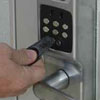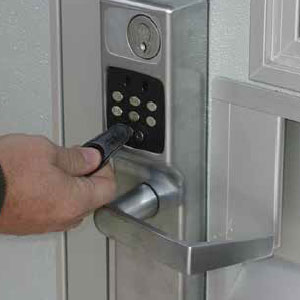
More Access Control
As school districts and parents are searching for increased comprehensive security measures for their schools, there are some basics that every school or college security administrator needs to know about access control.
- By April Noblitt
- Jul 01, 2013
 First of all, let’s remind ourselves what an electronic lock provides.
An electromagnetic lock, also called a magnetic lock or maglock, consists
of an electromagnet and an armature plate. There are two main
categories of maglock—the fail safe and fail secure. By attaching the
electromagnet to the door frame and the armature plate to the door, a
current passing through the electromagnet attracts (fail safe) or releases
(fail secure) the armature plate.
First of all, let’s remind ourselves what an electronic lock provides.
An electromagnetic lock, also called a magnetic lock or maglock, consists
of an electromagnet and an armature plate. There are two main
categories of maglock—the fail safe and fail secure. By attaching the
electromagnet to the door frame and the armature plate to the door, a
current passing through the electromagnet attracts (fail safe) or releases
(fail secure) the armature plate.
A fail-safe magnetic lock requires power to remain locked and is
not suitable for high-security applications because it is possible to
bypass the lock by disrupting the power supply. However, fail-safe
maglocks are well suited for use on emergency exit doors because
they are more reliable.
Fail-secure maglocks use a permanent magnet to keep the door shut
and use current passing through an electromagnet to cancel the permanent
magnet and release the door. These fail-secure locks are therefore
better suited to high-security installations. Because power is required to
release the fail-secure locks, more care is needed when deciding to use
them for safety reasons. For example, if a fire occurs and the power to the
building is cut, occupants may not be able to escape.
Functions available with electronic locks include:
- Basic mechanical functions—Electronic locks have all the functions
of mechanical locks plus two more.
- Office—The lockset is normally secure. This lock meets the need for
a lockdown function for safety and security. The inside lever is always
free for immediate egress.
- Privacy—The lockset is normally secure. The interior pushbutton
will disable normal electronic access from the exterior. The inside lever is always free for immediate egress.
Types of Electronic Locks
An electronic lock as described above is controlled by a reader—keypad,
card reader or biometric terminal. If the user has the right PIN,
card or biometric, the door unlocks. Typically readers are installed
next to the door.
The Cobb County School District (CCSD), the second largest school
system in Georgia serving more than 106,000 students with a total of
114 schools, upgraded access at its elementary schools with a Schlage
card access control system. Concurrently, it simplifies access management
and reduces maintenance costs, issues the schools faced when
access was controlled by mechanical keys.
Formerly, access to all schools was controlled by mechanical keys.
“The keys were marked, ‘Do Not Duplicate,’ but there were thousands
of keys out there,” said James H. Carlson, executive director of
CCSD maintenance services. “Each school was responsible for managing
its own keys, so it was hard to know who had them.”
To determine whether electronic access control was feasible, CCSD
ran a pilot test at one elementary school, installing proximity-card
readers and electric-latch retraction exit devices at the five most-used
entrances, including main doors, bus entrance, exit doors and playground
doors. All other exterior doors were locked and monitored.
Success meant the system would be installed throughout the district.
The system provides flexibility to accommodate school schedules. It
unlocks and relocks controlled doors according to schedule during
school hours. The system is programmed to eliminate automatically
opening for holidays throughout the school year. Occasional snow
days are easy to program.
Card access makes it easier to issue and delete credentials than issuing
new keys or getting them returned if someone leaves. Deleting a
lost card also is considerably less expensive than rekeying multiple
doors. In addition, cards can be programmed to operate for a limited
time or specific hours to control access for contractors or other visitors.
According to Carlson, the human resources department issues the
cards after background checks are complete. Each school can then give
an employee the right to access its building as required.
Other Locking Systems
There are two other types of locking systems.
Standalone, programmable, combination locks/readers offer a variety
of options that allow schools to customize the right solution for a
specific facility. Keypad only, proximity, magnetic stripe and dual credential
plus PIN options are available on these computer-managed
readers/locks. On some units, a key-in-lever design also lets users
leverage existing master key systems. Schools can control where people
go and when by setting up access rights and schedules in a central
database which gets transferred to the locks using software with a
handheld device. With some versions, audit trails can provide visibility
as to who accessed a door and when.
Maintaining key control and keeping security effective was difficult
with mechanical keys alone at the Birmingham, Mich., School District.
“We tried to limit the number of exterior door keys that we gave
each school because our buildings are alarmed,” said Rob J. Carson,
skilled trades and grounds supervisor. “Anybody with an exterior key
who tried to enter the building while it was closed would set off a silent
alarm if they didn’t realize it was armed or didn’t have the code to
disarm it.”
Only the main entrance doors to elementary and middle schools are
locked during school hours and their offices are located to give a clear
view of the front doors so the staff can see everybody coming in and
out. Once they started locking the buildings during the day, it became
difficult to maintain security while allowing re-entry from playgrounds
or parking lots.
“Dogging down a panic bar or blocking a door open compromises
security,” Carson said. “We needed to find a solution that would give
the principals a way to run their educational program and meet the
district’s goal of keeping the building secure.”
The district started investigating electronic access control but leaned
away from magnetic strip cards or other credentials that could be lost,
stolen, damaged or misused. The cost of providing cards, iButton fobs
or other credentials to a large number of people and managing or
replacing them would need to be funded and could be substantial.
Instead, they chose computer-managed locks that are programmable
and pushbutton-activated.
“PIN codes are free, and with people being used to having codes for
ATMs, we felt comfortable that they would be effective here,” said Carson,
who indicated that staff went through a training program on how
to protect the codes and use them properly, and the locks are programmed
to operate only during specific hours. “Our backup security
is that the code will only work during the times we permit it to work.
“After we program them on our computer, we download the information
to a Palm Pilot. We have an iButton key fob that puts the lock into a
programming mode. Then we just plug the Palm Pilot into the lock,
download it in a couple of minutes, and we are finished. We don’t have
to open them up like we did with the mechanical pushbutton locks.”
All access codes are canceled at the end of the school year and new
codes are issued and emailed to the principals at the start of the next
school year. Keeping control of the programming at the district office
helps maintain consistency and avoid unforeseen problems that could
occur if decisions were made at the school level without full knowledge
of the security and control implications.
“Their skill level is education, and ours is building management,”
Carson said.
Once the new codes are established, he or his employees reprogram
the locks using a PDA, which also updates the access schedule for
school holidays. At the same time, the batteries that power the stand alone locks also are changed.
If an employee leaves the district or a problem arises, the principal
typically notifies Carson by telephone or email so he can invalidate
that person’s code. Previously, it would have been necessary to re-key
the school’s exterior doors and issue new keys to everyone.
All-in-one Systems
Modular all-in-one locking systems combine the lock and reader so
that a school can now choose the specific electronic lock they need
now with full confidence that it can be later upgraded without ever
taking it off the door. Components that have been traditionally located
around the door are now integrated into the lock itself to yield a smarter
solution and more value for the investment. The locks provide multiple,
interchangeable credential reader modules as well as interchangeable
offline, wired and wireless networking modules so that
access control can now be installed at doors where it had been previously
unfeasible. The locks are compatible with all popular exit devices,
provide a host of power and cylinder options, offer field configurable
settings and include a wide variety of finishes and levers.
Miami University in Oxford, Ohio, selected such a locking system.
Since these locks are designed with easily changeable reader modules,
they can be upgraded in the future without changing the entire lock.
The locks simplified the installation process because they combine all
the hardware components required at the door into one integrated
design. They incorporate the electrified lock, credential reader,
request-to-exit and enter sensors, door position switch and tamper
guard. Their wireless operation also made them easier and more costeffective
to install in the existing buildings on campus.
The near field communication (NFC) capability of the locks makes
them compatable for the future, according to Steve Thole, director of
business systems and technology at Miami University. As more smartphones
become NFC-capable, students are highly likely to prefer using
them as their primary credential. Already, nearly half of all college
students nationwide are using cell phone apps on campus for managing
class work, checking grades and bookstore purchases. As apps
become available, the university will not have to upgrade the readers to
use smartphone credentials.
In addition to the security benefits, the university is realizing substantial
cost savings by eliminating rekeying and minimizing lockout
calls. Previously, there were between four and six keys issued for a
typical door and the university was generating nearly 1,200 locksmith
work orders per year under the mechanical key system. The re-coring
and rekeying costs associated with a lost master key could run as high
as $15,000 and it could take several days to complete the task.
When Specifying a System,
Start with the Specific Door
Lastly, regardless of the electronic access control system you and your
school choose, you do not need to specify the same model of door
hardware throughout a school. In some areas, you will want hardware
that is quieter than standard. Other areas need higher security hardware,
such as a large district’s computer center. Some areas need extrastrong
hardware to combat high winds, while in other spots, such as
the superintendent’s office, the door hardware can
be fancier. You should always choose what’s right
for each specific location.
This article originally appeared in the July 2013 issue of Security Today.